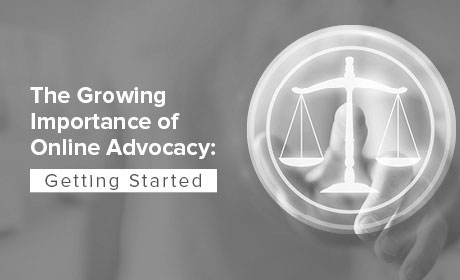The growing importance of online advocacy: getting started

As the nonprofit sector and the economy as a whole face unprecedented levels of disruption, planning out your nonprofit’s next campaign can certainly feel daunting. What works in a new virtual environment? What will be engaging for your supporters when they’ve got new concerns of their own? For nonprofits of all sizes, online advocacy is becoming an increasingly effective choice.
Online advocacy campaigns, anchored around raising awareness or mobilizing political and social support for new legislation, tie together a number of key forces facing the nonprofit sector today:
- The new importance (and necessity) of online engagement for nonprofits
- Surging public interest and awareness around missions related to social, economic, and public health issues
- Increased digital engagement across the board amid social distancing and remote work
Along with crisis responses like #GivingTuesdayNow and emergency loan and relief programs, online advocacy represents a major opportunity for savvy organizations in 2020 and beyond.
These types of campaigns have always served as effective outlets for engagement. They facilitate important conversations, raise visibility for relevant causes, and deepen your relationships with supporters. All of these are crucial for maintaining your donation levels over time. With the new reality of virtual fundraising, each of these benefits is more important than ever!
In this quick guide, we’ll walk through the essentials of online advocacy, including:
- Online advocacy infrastructures and tech
- Recruiting and engaging your advocates
- Other important considerations
As events unfold at the federal, state, and local levels, it’s vital that nonprofit missions are part of the conversation. Online advocacy is the best way for organizations to mobilize support and ensure that their communities’ voices are heard. If your nonprofit’s own mission relates to current concerns (or if your constituency has been impacted by recent events), read on for an overview of what you’ll need to get started.
Online advocacy infrastructures and tech
There are a few key elements you’ll need in order to begin planning your next online advocacy push.
- A relevant mission. Issues relating directly to the coronavirus pandemic are well positioned for online advocacy, but the pandemic’s much wider economic impacts mean that nonprofits with all kinds of missions have a stake in what’s happening. Think about your unique perspective and how your own community has specifically been impacted.
- A specific goal. You’ll also need a specific target to build your advocacy efforts around. Mobilizing petition signers and constituents by promoting (or critiquing) upcoming legislation related to your mission are classic examples. If your goals are intangible or too vague, it becomes difficult to maintain the campaign’s energy and motivate supporters.
- An online audience. For your online advocacy efforts to succeed, you’ll need a digitally engaged base of support. Of course, your online audience will grow—that should be a core aim of your campaign. If, however, you’ve never done much online outreach before or don’t have social media accounts for your nonprofit, you’ll need to build out that foundation before diving straight into online advocacy.
You’ll also need the right tech infrastructure in place to translate your support into concrete digital actions and long-term benefits for your nonprofit. Your nonprofit’s tech stack should contain a number of important elements:
- Customer relationship manager (CRM). At the base of your tool kit should be a CRM or database. This resource will be essential for both guiding your initial outreach and recording all of the valuable data that your online advocacy campaign generates. For instance, you’ll definitely want to get back in touch with new supporters who sign your petitions, so save their contact information in your CRM.
- Advocacy-specific software. The software should include online petition creators, custom form builders, and tools allowing supporters to contact their legislators.
- Communications software and an online presence. To spread the word about your campaign and grow your audience, you’ll also need email software, active social media channels, and a blog on your website where you post regular updates.
- Robust online donation software. Although fundraising isn’t typically the core goal of an online advocacy campaign, many supporters will still be motivated to give financially to help you continue your work. Software to help you collect and process those gifts is a must. If your nonprofit’s current tools aren’t delivering, this guide to nonprofit payment processing will help you learn more about potential improvements.
With the prerequisites listed above plus a tech infrastructure to support your efforts from beginning to end, you’ll be in a good spot to begin planning and launching your advocacy campaign.
Recruiting and engaging your advocates
As the global philanthropic response to COVID-19 grows (more than $10 billion as of the first week in May), it’s clear that there’s plenty of institutional support and motivation for nonprofit work around this pandemic and its effects. But how do you tap into that energy at the individual, grassroots level?
Online advocacy is an effective route for nonprofits precisely because it relies on grassroots support from individual advocates to spread the word on your behalf.
Decentralized, individual-centric methods that empower supporters to act on their own are highly effective in today’s digital landscape. For your advocacy campaign, your advocates will help to promote your campaign, raise awareness online, and facilitate discussions between supporters. Consider these best practices for recruiting and empowering those advocates:
- Look first to your existing base of support. Before fully launching your advocacy campaign, it’s a good idea to recruit advocates who can help from the get-go. Review your CRM and volunteer management systems to identify individuals most likely to get involved. Then personally reach out to them. Loyal volunteers will likely be eager for new ways to engage with your mission virtually, and their excitement and energy will be invaluable for powering your campaign.
- Create a lead capture campaign to recruit new advocates. Use your website, emails, and social media posts to source new advocates from your online network. Create digital content explaining your campaign, its goals, and why it matters. Online users who engage with your content or provide their contact information to learn more could make strong advocates for your cause. Additionally, offering do-it-yourself-style peer-to-peer fundraising options on your website makes it easier to quickly identify supporters motivated enough by your mission to actively fundraise for it on their own.
- Empower your advocates with the right resources. Once you’ve recruited advocates and launched your campaign, you need to make sure they have everything they’ll need to be successful. Offering a directory of relevant resources on your website is a smart move, as is hosting one or more virtual training sessions to discuss your campaign’s goals in a more personal way. Nonprofit letter templates and sample social media posts will be useful for your advocates as well. Don’t forget to proactively ask them what additional resources would be helpful and to check-in periodically on their efforts.
Look to other sources of support that your advocates might be able to leverage as well. For example, corporate partners (large or small) can help your advocacy campaign by amplifying your voice, sponsoring a virtual outreach event, making donations, or providing financial matches to gifts made by employees. Corporate philanthropy is becoming more impactful than ever amid today’s challenges. Exploring these types of opportunities and then equipping your advocates to tap into them can be game-changing for your campaign.
Other important advocacy considerations
If your nonprofit is new to online advocacy (or if you’re just looking to refine your strategies for 2020), there are a few additional considerations and best practices to keep in mind:
- Understand what constitutes nonprofit advocacy and stay compliant. Although advocacy is more broadly about making your supporters’ voices heard and helping to facilitate policy discussions (think petitions or get-out-the-vote campaigns), lobbying specifically describes influencing legislation (such as making political contributions). This can be a tricky distinction, so spend some time researching your applicable restrictions. Filing Form 501(h) can help keep your efforts compliant and transparent to the IRS.
- Customize your materials whenever collecting data. For your online advocacy campaign to yield long-term benefits for your organization, you need to collect the right data. Customizable forms and petitions are essential for ensuring you can get back in touch with supporters and better target them in the future. If your website could use more extensive or tech-heavy customizations, explore this nonprofit web design guide for an idea of what to expect from the process.
- Set relevant key performance indicators (KPIs) for your advocacy campaign. One challenge of advocacy is that it can be difficult to measure your progress toward your ultimate goals of effecting change (versus reaching a concrete fundraising total in a typical campaign). By setting relevant key performance indicators early in the planning process, you can combat this challenge. Total signatures, new supporter acquisition, and online engagement metrics are all useful KPIs for advocacy, but set yours based on the specifics of your campaign.
- Understand the scope of your efforts. Is your organization aiming to create change at the local, state, or national level? You’ll need to use tools that are properly scaled to your efforts. For example, in order for your online supporters to look up and then contact their federal representatives, your software provider must be an approved Communicating with Congress partner.
- Use additional tools to boost fundraising throughout the campaign. Although soliciting donations isn’t the purpose of advocacy, an effective online advocacy campaign will likely result in a boost in donations as your online audience grows. Make sure your online donation software is ready to handle the increased traffic! Consider additional donation tools and resources to boost the impact of those donations even further, such as matching gift databases and prospect research integrations.
- Remember to spend enough time planning your online advocacy campaign. Although it can be fairly tempting to recruit advocates, launch your campaign, and let it run its course, truly successful advocacy requires proactive direction and planning. Thinking through exactly how you’ll reach new audiences, what you’ll ask supporters to do, and then what you’ll do once you’ve reached your goal will boost your chances of making a tangible impact.
Closing thoughts
Online advocacy can help you meet the challenges of 2020—the coronavirus pandemic, its economic impacts, elections at all levels, and surging public interest in and awareness of nonprofit work—head-on. Your nonprofit can serve a crucial role as a voice for your community!
Your nonprofit can see major benefits from educating, empowering, and mobilizing your supporters toward a shared goal. Not only will you be actively working toward your mission during a time of disruption but you’ll also be deepening relationships with supporters and reaching new ones.
With the right resources and preparation, you’ll be sure to grow your impact over the coming months. Best of luck!






